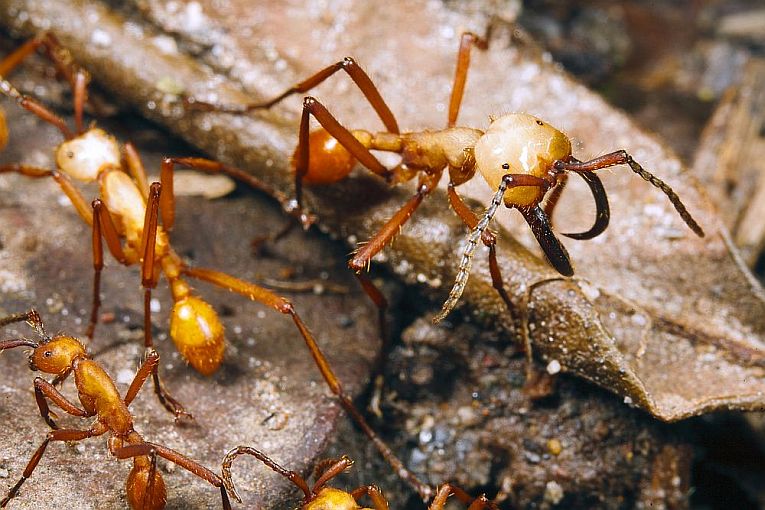The Amazon, the Congo and parts of SE Asia possess one of the most admired killing machines known to us. The army ants are super-organisms in the sense that they act as one, despite being composed of a colony of millions of individuals. They were named Dorylines after the admirable abilities of ancient Greek soldiers, but the species here is Eciton harmatum from Barro Colorado Island in Panama, with our pictured soldier living in Ecuador.
Chris R. Reid, Matthew J. Lutz, Scott Powell, Albert B. Kao, Iain D. Couzin and Simon Garnier have published an informative paper on the behaviours of this species in constructing complicated structures from their own bodies, when they want to cross a gap in their path. The work investigates how these bridges
lengthen, widen and also migrate in order to overcome obstacles. Worker ants (not soldiers!) are used for the construction and so reduce the number available for foraging along their infamous and deadly trails. The research indicates that such a magnificent gesture is a trade-off just as the construction of a human-engineered self-assembly system can provide a benefit in terms of its outcome and the cost involved. The possibility is that robots, like ants, could engineer
bridges or similar constructs in situations where humans could not penetrate such as disaster zones.
The rarity of individuals cooperating in making a structure draws our attention to these ants and only one or two other social insects. As their forest habitats rapidly dwindle worldwide, their own rarity is a cause for concern. The advantage of a bridge is purely to get the food sources back to the centre of the column as quickly as possible. As with much research these days, the construction of algorithms forming a computer model acting as a functioning copy of the natural system was intrinsic to the research.
Self-organisation leads the animals to a kind of swarm intelligence
that functions to create the best fit of individual cooperation. The blind individuals therefore move to join the bridge. They can also return to active duty depending on the ants’ pheromones, created when congestion is detected along their trail. Sighted ants also use pheromones as seen in our Ant Crowd Control story on a more familiar genus. These smells
simply indicate the prime needs at any one time for the colony. As a static structure, these bridges are remarkable; as dynamic adaptive structures, they become a unique attribute of these nomadic species.
The work can be viewed in PNAS or with several videos from Princeton University at Army ants dynamically adjust living bridges in response to a cost–benefit trade-off. The German and US co-workers worked their magic by using a 1.5 foot high apparatus with ramps on which gap sizes and 4 different angles could be adjusted. Next on their agenda comes another South American, the species in our own photograph, Eciton burchelli. Using the comparative technique, maybe even more can be discovered about how animal engineers cut costs.










